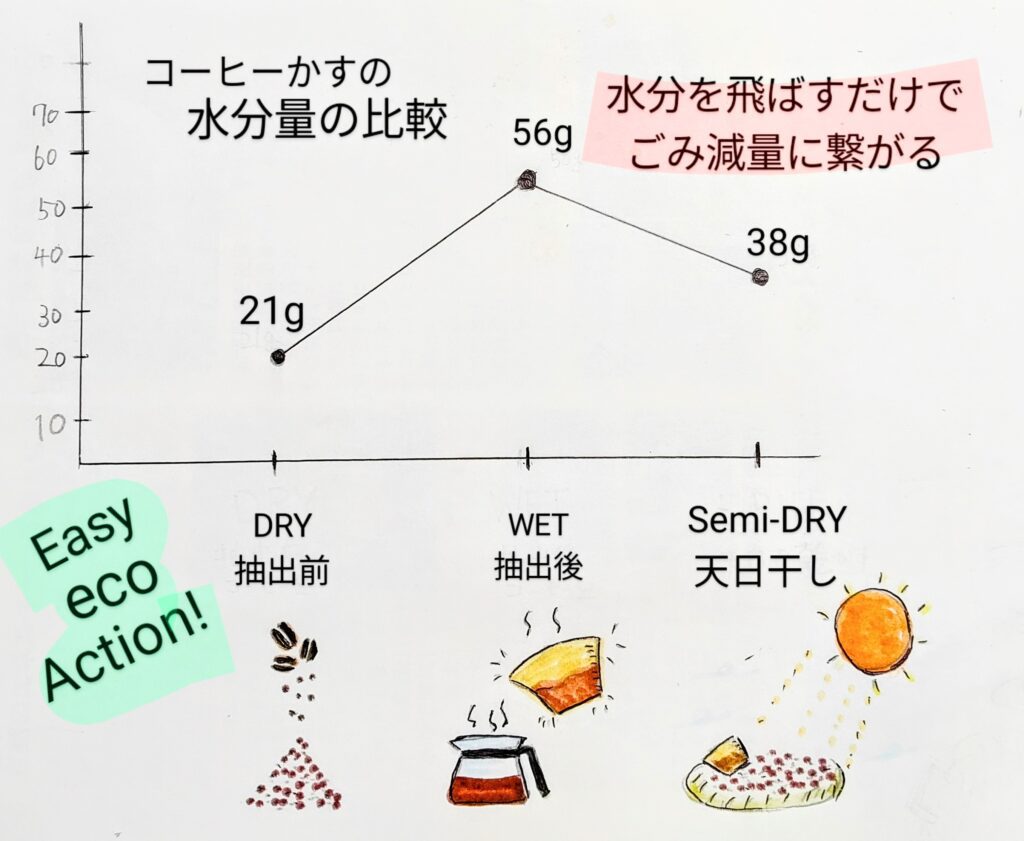Dry Your Coffee Grounds Before Throwing Them Away!
Do you make coffee at home and throw away the coffee grounds?
If so, here is an easy way to quickly take a big step forward in reducing the weight of your coffee waste.
We started the mame-eco project in Kyoto in 2020 to support efforts around Japan and elsewhere to turn coffee grounds into compost instead of throwing them away.
That includes our network of collection spots in Kyoto for individuals to use, in addition to our collections at cafes and hotels and businesses.
But we recognize that not everyone who would like to recycle their coffee grounds can start right now. You might not have a garden or know anyone who can use your grounds, for example.
Coffee grounds contain a significant amount of water, which increases the energy it takes to transport coffee grounds to the incinerator and burn them. Waste in Japan is burned.
The good news is that unlike most other types of food waste, the water in coffee grounds is added on purpose just before they are used, so a lot of that water can be easily removed before you throw them away! And so, there is a big opportunity here for improvement even if you continue to throw away your coffee grounds.
For example, we have a typical home coffee maker that uses paper filters.
Since we give our grounds to farmers as part of the mame-eco project and also use some in our small garden, we normally don’t need to be concerned with reducing their water weight before the coffee grounds are recycled.
But for the purposes of this demonstration, we did a simple experiment at home to see what effect drying the grounds on a sheet for a few hours or so outside would have on their weight.
Here is the data:
- We started with 22 grams of dry coffee grounds, enough to brew two cups of coffee according to our machine’s instructions.
- After brewing, we removed the wet grounds from the filter and weighed them again. They weighed 61 grams, significantly more than before we made our coffee.
- We put them outside and let them partially dry for part of an afternoon. Then we weighed the coffee grounds again and they weighed 40 grams.

What did we learn from this simple experiment in general terms?
The final weight after a little passive outdoor drying was still almost twice what it was before we added the water before brewing our coffee, but the amount of weight lost with this simple, quick process was a significant improvement!
So if we make just two cups a day in this way, this simple, almost effortless step would reduce our monthly garbage weight by roughly 630 grams, which is a significant benefit compared to the minimal time and energy that this outdoor drying method requires.
(In our case, we actually drink much more than this, so this method would reduce the weight of our garbage by well over one kilogram a month if we were throwing our coffee grounds away instead of recycling them!)
We mentioned above the special quality that coffee grounds have compared with most other food waste, in terms of having had their water content purposefully added, making it relatively easy to reduce some of that extra weight after use.
In addition to that, coffee grounds are a great candidate for this easy and effective energy saving air-drying technique because they don’t smell bad and attract few insects while drying, in contrast to most other food waste. So, even if you just have a balcony available for drying, you can use this method without worry.
The Main Point
The point of this post is that we don’t have to totally give up on taking positive action when we can’t easily make the optimal choice.
Being perfect is not the goal, after all. Doing something feels much better than doing nothing, and it does make a difference!
And sometimes, of course, a simple step can open the door to further action as we get the time and resources to do various things and are encouraged by our initial success.
The ‘mame’ in mame-eco refers to coffee beans, but it is also about taking small actions and not giving up before we even start.
Make it easy, and have fun!